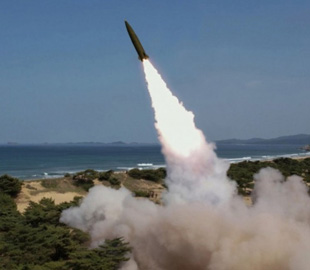>> c11eea0.jpg” alt=”North Korea tested the Hwasong-11D ballistic missile of the KN-23 type with a new guidance system” />
North Korea showed tests of a tactical ballistic missile that received “new guidance technologies” with the indication that it is about some kind of “autonomous navigation system”.
There are no other details that the North Korean agency released today, May 18, except for Kim Jong-un's prominent participation in this process. The shootings themselves took place on May 17, and the photo shows a subspecies of KN-23 missiles – Hwasong-11D.
Although the type of missiles itself is not indicated, a number of details indicate this, including the launch, inclined launch, shape and color of the missile.
We note that in general the Hwasong-11 family includes the basic Hwasong-11A – KN-23, Hwasong-11B – The KN-24 is visually similar to the ATACMS, the Hwasong-11C, which is an enlarged version, the Hwasong-11D – scaled down version and Hwasong-11 S for submarines.
The Hwasong-11D, as a scaled-down copy, is said to have an estimated range of up to 180 km. But these estimates can be underestimated. Because for the KN-23, the estimate of the size of the combat unit at a range of 650 km was up to 500 kg, but it turned out that we are talking about an indicator of up to 1000 kg.
And now in the West it is assumed that the range of the KN-23 can to be up to 900 km. And in this way, the range of the Hwasong-11D, which may turn out to be more than 180 km, may be worth sprinkling.
Due to its smaller dimensions, there are up to four missiles on one launcher. And the launch is not carried out vertically, but at a certain angle. Their mass launch was demonstrated in March 2023.
It is worth reminding that the Hwasong-11A (KN-23) is developed on the basis of the Russian 9M723 for the Iskander OTRK. And missiles of the KN-23 type were exported by Pyongyang to the Russian Federation in the amount of about 50 units, half of which exploded or disintegrated in the air, another part – did not achieve its goals due to misses.
And in this situation, an extremely realistic scenario is that Moscow transfers to the DPRK additional technologies, solutions and components that should make their missiles more reliable and accurate.

